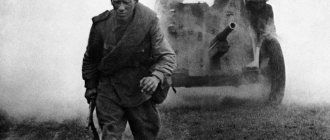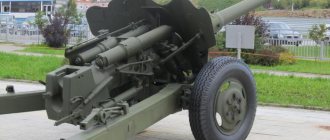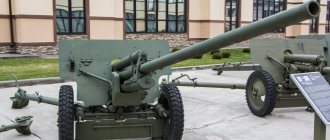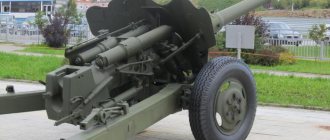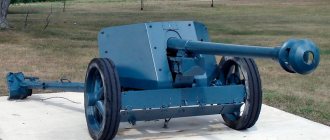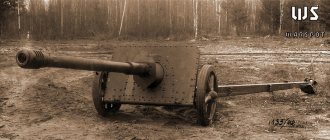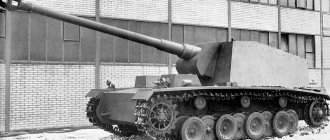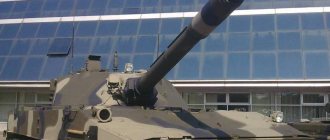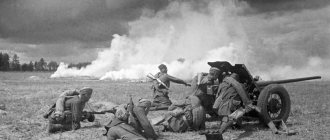Author: zaCCCPanec
15 August 2022 15:02
Tags: artillery stories about weapons forty-five pages of history
2581
12
We continue the theme of historical investigations, since the debut turned out well. Today on the agenda is the issue of caliber. Caliber 45 millimeters, a caliber that existed in one and only country - the Soviet Union, in service with one army - the Red Army.
0
See all photos in the gallery
And here there are not just a lot of unevenness and roughness. Let's start with the fact that for some reason the majority of researchers talk about a 45 mm anti-tank gun, completely ignoring the rest. Probably because Comrade Shirokorad didn’t write, and without him it’s difficult to swing, I agree. But Shirokorad really wrote about the anti-tank gun, and wrote well. Which, however, is not a reason to forget all the other guns. The rest are a tank gun, a battalion howitzer, an anti-aircraft gun, a semi-automatic universal gun, and a naval gun. And that’s it – 45 mm.
0
45-mm universal gun of the cruiser "Red Caucasus".
×
You will say that tank/anti-tank are the same thing. Well, yes, but the methods of attachment and movement are slightly different, as well as the shells that were used. Tanks fought with tanks only against not very good military leaders. Good tanks drilled pillboxes, bunkers and everything else, which mostly required high-explosive shells. However, we have written quite a lot about this, there is nothing special to invent. As an interim result, we note that 45 mm is not exclusively an anti-tank caliber of the Red Army. There were more than enough guns of this caliber, and this, I must say, greatly shakes the opinion of Alexander Borisovich, whom I respect.
0
Why? It's simple. If you look at a single “forty-five”, then yes, everything fits, and the version works. If you look at the caliber as a whole, no, no, and no again. So, the version of Shirokorad and followers. The famous “forty-five” is the superimposition of a 37-mm 1-K anti-tank gun of the 1930 model on the carriage of its own barrel, bored to 45 mm. Logically, the technique is as old as the world, nothing new. If the base allowed, we sharpened everything. Not only ours. It’s also worth saying a few words about the 1-K gun itself, although we wrote about it. Yes, this is the same 3.7 cm anti-tank gun of the 1926 model, bought by the Soviet Union through a front gun. Bought “with giblets”, that is, with all possible technological documentation. For a little over a million (1.125 million, to be exact) dollars.
0
Only half a thousand 1-K guns were produced, but the military did not like the gun, it seemed downright weak (the Great Patriotic War confirmed this), and the gun was quickly replaced with a 19-K. 45-mm caliber... Although... Currently, there are several versions about how this strange caliber was formed in our troops. There was a standard caliber of 47 mm in the world, why did everything turn out “not like everyone else”?
Version No. 1
0
Hotchkiss 47 mm gun
Version No. 1 states that allegedly it was impossible to install a barrel from the same 47 mm gun on the carriage of a 37 mm gun, so it was cut down to 45 mm. I don’t even want to criticize or dissect the version. 2 (TWO!) millimeters. On the gun carriage. What kind of admission is this that could not be accommodated? Or perhaps the 47-mm cannon had such a powerful projectile that the design of the carriage could not withstand it? Well, it’s more or less suitable, but I’ll cite a sign from an article about anti-tank guns of World War II. And there it is clear that the 45-mm gun is in no way inferior in terms of power to its 47-mm sisters. And some are even superior. In any case, whether there are dimensional or strength flaws – well, it looks stupid. The Hotchkiss gun produced an initial projectile speed of 701 m/s versus 760 m/s for the 1932/37 model gun. For an armor-piercing projectile the difference is not very critical, but for a high-explosive fragmentation projectile you don’t even need that much. This is evidenced by such a value as the mass of the powder charge: the Hotchkiss gun has 350 g, the “forty-five” armor-piercing shells up to 360 g. And the high-explosive fragmentation projectile ejected 100-115 g of gunpowder.
Stories about weapons. 45 millimeters god of war
Artillery is the god of war.
An ancient and indisputable saying, a well-deserved nickname. Today's story is not about those who were the first to launch an offensive and crush the enemy at his not so close lines. We are talking about those who took the first blow of the advancing troops on all fronts of the Great Patriotic War and the Second World War. Forty-five. Probably no other gun has been the subject of so many stories and disputes. But we are breaking spears today, and from 1941 to 1945 the forty-fives on the first line of defense (and offensive) did their job. They broke the armor and chassis of German tanks and self-propelled guns, drove shells into the embrasures of pillboxes and bunkers, and hit the infantry with grapeshot and high-explosive fragmentation shells.
Forty-five was on the front line throughout the war, the infantryman’s best friend. The rest of the gods of the division level and above were still a little further away.
Where did this story even begin?
Oddly enough, but since the defeat of Germany in the First World War. It was because of the terms of the Treaty of Versailles, or rather, thanks to them, that German 37-mm anti-tank guns came to the USSR. And documentation for them.
Thus, Soviet anti-tank artillery was born.
At the end of 1931, the designers of Plant No. 8 installed a new 45-mm caliber pipe into the casing of a 37-mm anti-tank gun of the 1930 model, built according to purchased German documentation.
After the first tests, the carriage had to be modified in terms of strengthening.
This system was put into service in March 1932 under the name “45-mm anti-tank gun model 1932”; at the factory the gun received the index 19-K. Then the designers of Plant No. 8 redesigned the 19-K field gun for installation in a tank, called the “45-mm tank gun mod. 1932" and, accordingly, the factory index 20-K. We will return to the 20-K gun later.
1. 45-mm anti-tank gun, model 1932.
The 1932 model gun was actually quarter-automatic, semi-automatic was of the inertial type and worked due to the inertia of the recoil.
When firing armor-piercing shells, the semi-automatic gun worked quite normally. But when firing a fragmentation projectile, the semi-automatic did not work, since there was not enough recoil energy to cock the semi-automatic springs. Thus, for fragmentation shells, the 45-mm cannon of the 1932 model remained quarter-automatic.
In 1934, a new modernization of the gun was carried out, and the gun again received a new name “45-mm anti-tank gun mod. 1934." The modernization of the gun consisted of replacing wooden wheels with Ford wheels from a GAZ-A car on pneumatic tires, and changing the turning mechanism.
On April 22, 1934, the Artillery Directorate of the Red Army considered the proposal of designer B. Shpitalny to rework the 45-mm cannon mod. 1932 automatic. According to the OKB-15 project, a new barrel, a new bolt and a magazine for 6 rounds were introduced. AU agreed with Shpitalny's proposal and issued an order for the production of a prototype by the fall of 1934. A prototype of the 45-mm automatic cannon was manufactured and tested, but was not accepted for service. The introduction of full automation for the 45-mm anti-tank gun was impractical due to the decrease in the reliability of the gun and the increase in its weight compared to a semi-automatic gun.
Ammunition for 19-K: 1. UBR-243P with BR-240P sub-caliber armor-piercing projectile. 2. UBR-243SP with a solid armor-piercing projectile BR-240SP. 3. UBZR-243 with an armor-piercing incendiary projectile BZR-240. 4. UO-243 with O-243 fragmentation grenade. 5. USH-243 with Shch-240 buckshot.
In total, about 12 thousand of these guns were produced.
The 45-mm 19-K cannons were precisely the masses of artillery that met the German tanks. Together with the next hero of our story.
2. 45-mm anti-tank gun, model 1937.
It was used at the first stage of the Great Patriotic War, but due to insufficient armor penetration it was replaced in 1942 by a more powerful M-42 cannon of the same caliber. The 1937 model gun was finally discontinued in 1943.
During 1937-1943, USSR industry produced 37,354 such guns.
Unlike previous models of anti-tank guns, the wedge breech of this gun is equipped with a semi-automatic mechanism, wheel suspension has been introduced into the carriage design, and ballistic characteristics have been improved.
The semi-automatic shutter worked both with an armor-piercing projectile and with a fragmentation projectile, unlike the 1932 model gun. This was achieved by forced cocking of the semi-automatic springs at the moment of the shot.
A special push-button release from the “cap” located in the center of the steering wheel of the lifting mechanism has been introduced.
Crank-spring type suspension was introduced, which was first implemented in the USSR in this system.
Instead of the wooden wheels of the 45-mm cannon of the 1932 model, automobile wheels of the GAZ-A type with sponge rubber were installed. The ZIK-1 wheel is converted from a GAZ-A car wheel with minor changes in the spokes.
The upper and lower machines have a riveted-welded structure made of sheet steel, and not cast, like their predecessors.
A new rotary mechanism has been introduced.
The gun was intended to fight enemy tanks, self-propelled guns and armored vehicles. For its time, its armor penetration was quite adequate - at a normal distance of 500 m it penetrated 43 mm armor. This was enough to fight armored vehicles protected by bulletproof armor.
To improve armor penetration, a 45-mm sub-caliber projectile was adopted, which penetrated 66 mm of armor at a distance of 500 m, and 88 mm of armor when fired at a dagger fire distance of 100 m.
The gun also had anti-personnel capabilities - it was equipped with a fragmentation grenade and buckshot. A 45-mm fragmentation grenade, when exploded, produces 100 fragments that retain destructive power when scattered along the front by 15 m and in depth by 5-7 m. When fired, grapeshot bullets form a damaging sector along the front up to a width of 60 m and a depth of up to 400 m .
Insufficient armor penetration of the gun (especially in 1942, when tanks of the Pz Kpfw I and Pz Kpfw II types, along with the early lightly armored modifications Pz Kpfw III and Pz Kpfw IV practically disappeared from the battlefield), together with the inexperience of the artillerymen, sometimes led to very heavy losses.
But in the hands of experienced and tactically skilled commanders, this weapon posed a serious threat to enemy armored vehicles. Its positive qualities were high mobility and ease of camouflage. Thanks to this, 45-mm cannons of the 1937 model were used by partisan detachments.
3. 45-mm anti-tank gun model 1942 (M-42).
It was used from 1942 until the end of the Great Patriotic War, but due to insufficient armor penetration it was partially replaced in production in 1943 by the more powerful ZIS-2 cannon of 57 mm caliber. The M-42 gun was finally discontinued in 1946. During 1942-1945, USSR industry produced 10,843 such guns.
45-mm anti-tank gun mod. 1942 M-42 was obtained by modernizing a 45-mm cannon of the 1937 model at plant No. 172 in Motovilikha. The modernization consisted of lengthening the barrel, strengthening the propellant charge and a number of technological measures to simplify mass production.
The thickness of the shield cover armor was increased from 4.5 mm to 7 mm to better protect the crew from armor-piercing rifle bullets. As a result of modernization, the muzzle velocity of the projectile increased from 760 to 870 m/s.
The gun was intended to fight enemy tanks, self-propelled guns and armored vehicles. It was capable of successfully fighting all medium tanks of the Wehrmacht in 1942. However, the appearance in 1943 of significant quantities of new heavy tanks “Tiger”, “Panther” and the modernized Pz Kpfw IV Ausf H with a frontal armor thickness of 80 mm once again confronted the Soviet anti-tank artillery with the need to increase firepower.
This was accomplished by re-adopting the 57 mm ZIS-2 anti-tank gun. However, thanks to the well-functioning production mechanism for the production of the M-42, the ability to fight the Panther and Pz Kpfw IV Ausf H by firing at the side and the high mobility of this weapon, it was left in production and in service with anti-tank units of rifle units.
4. 45-mm anti-tank gun, model 1941.
This gun was produced at the enterprises of besieged Leningrad. A number of 20-K tank guns were discovered in the warehouses. The factory workers made machine tools, carriages, shields, and the cannon began to arrive to units of the Leningrad Front.
Shards in the wheels... a chipped shield... Restoring this gun took more than one year.It is very difficult to say how many of these guns were manufactured today, but they were used everywhere in the defense of Leningrad. History has preserved chronicle footage.
To date, only two of these guns have survived. The first is in the tank museum of the city of Parola (Finland), the second, which is in the photo, is in the military history museum in Padikovo, Moscow region.
Small, light, mobile, capable of being exactly where it is most needed, the forty-five went through the entire war with honor, from beginning to end. From the first shots on the border in 1941, to the last in Manchuria and China.
Sources: Shunkov V.N. Weapons of the Red Army. Shirokorad A. B. Encyclopedia of domestic artillery. Museum of Military History, p. Padikovo, Moscow region.
Version No. 2
0
Version No. 2 looks more serious, and is advocated by Shirokorad and other (very numerous) supporters on the forums. According to this version, supposedly after the revolution, a large amount of armor-piercing ammunition for the aforementioned 47-mm Hotchkiss naval gun accumulated in military warehouses. Okay, there was such a gun. Yes, at that time it was completely outdated, and yes, its shells at sea were theoretically completely useless, so they decided to transfer them to land and use them as anti-tank/infantry support weapons. There weren't very many tanks at that time. Okay, there was such a gun. Yes, at that time it was completely outdated, and yes, its shells at sea were theoretically completely useless, so they decided to transfer them to land and use them as anti-tank/infantry support weapons. There weren't very many tanks at that time. We need to unload the shell. That is, remove it from the sleeve. Then remove the fuse. Yes, just in case. And then you can tighten the projectile into the cartridge and grind the belt. Without a real prospect of getting caught in the explosion of this shell. Next, reinsert the projectile into the cartridge case, restore the seal again, and yes, you can shoot. I immediately have a question: wouldn’t it have been easier to just make a 47-mm cannon and not engage in perversions? Now experts will begin to say that the Hotchkiss gun’s grenade flew at a speed of 700 m/s, the 19-K’s speed was already 760 m/s, and the M1932’s was 820 m/s. And the unfortunate belts could be torn off. I agree, initial projectile velocities have increased. And it was quite possible to rip off the belts. However, there is a nuance here that spoils everything. Namely, a complete lack of data. “There are a lot of shells in warehouses” - how many pieces? Nobody says the number. Yes, in principle, it is unrealistic to name it, because the Russian-Japanese, World War I, Civil War plus the eternal Russian mess.
0
The fact that 47 mm is useless became clear back in the Russo-Japanese War. It was not for nothing that hundreds of Hotchkiss guns were removed from ships, installed on at least some semblance of machine tools and sent to the front line in order to somehow compensate for the shortage of battalion and regimental guns. And since an armor-piercing shell was completely useless for infantry in those years, it is not surprising that these shells were simply lying around in warehouses. It's logical, it's undeniable, it's normal. Another question is how many are in grams... This is a complete mystery, but I think that there were quite a few of them there. If the tsar’s reserves were enough for half of the Great Patriotic War (76.2 mm), then 47-mm “goods” could have been in excess. And here a dual feeling arises. Well, if there are mountains of shells right there, take them and shoot - I return to the question of whether it would have been easier to make a barrel for shells. Simply, at Obukhovsky they deployed not such calibers. Plus (very significant) it would be possible “if something happens” to intercept shells from the allies. During the First World War, both the British and the Americans supplied us with 76.2-mm shells, not exactly to the fullest extent, but they supplied us. But if there are not so many shells, then it is quite possible to decide on such an adventure as regrinding a shell. What are they lying there? Well, let them be useful, such shells can easily be used as combat training, why not? The benefits are huge, the savings are huge, training costs are reduced, let the artillerymen hit with this antiquity for training purposes... But I repeat, it’s very, very doubtful that it’s millions. I found a figure that on January 1, 1901, the Navy Department had 963 47-mm Hotchkiss guns. From this we conclude how many shells for a thousand guns could be in the warehouses. And since we are talking about the fact that there were frankly few guns, it follows that there were hardly millions of shells lying around for them. A couple hundred thousand at most. We are talking about the movements of the 30s of the last century, when the First World War, the Civil War, and the intervention had already died down. And they ate their shells. So it turns out that the mosaic is not quite coming together.
Fragmentation projectiles
Fragmentation projectiles
In field artillery, a high-explosive fragmentation grenade is used. The explosion of a high-explosive fragmentation grenade with the fuse set to delayed action is shown in Fig. 36.
Rice. 36. View of the explosion of a high-explosive fragmentation grenade with the fuse set to delayed action
.
Unlike a high-explosive projectile, a high-explosive fragmentation grenade (Fig. 37) has an explosive charge of less weight, and the walls of the body are thicker.
Rice. 37. 76-mm high-explosive fragmentation grenade
.
This is done so that when firing with the fuse set to fragmentation action, as many fragments as possible are obtained.
A high-explosive fragmentation grenade is fired to destroy enemy personnel and material.
A projectile with a fuse set to fragmentation when it explodes (Fig. 38) produces many fragments, but not all fragments are lethal.
Rice. 38. Exploding a grenade with the fuse set to fragmentation action
.
A lethal fragment is considered to be a fragment weighing at least 5 g. When a 76-mm grenade ruptures, such lethal fragments are obtained in 200-250 pieces, 107-mm - 300-400, 122-mm - 400-500 and 152-mm - 500-700 PC. In addition, not all fragments are destructive, since some of them are directed downward into the ground, and some upward (Fig. 39).
Rice. 39. Scattering of grenade fragments
.
They are mainly affected by fragments that fly to the sides (along the surface of the earth). Therefore, it is advantageous for the projectile to fall to the ground at approximately a right angle (90°). Shrapnel damage increases if the projectile explodes in the air at a height of approximately 12 m.
Air bursts can be obtained by shooting on ricochets (Fig. 40), shooting at tree branches (Fig. 41) or remote shooting (a projectile with a special remote fuse that allows you to get a gap at any height).
Rice. 40. Explosion of a grenade after a ricochet
.
Rice. 41. Grenade exploding in tree branches
.
To defeat openly positioned infantry, cavalry and infantry moving on vehicles and tanks, it is good to use shrapnel.
Shrapnel (Fig. 42) is a steel glass (case) inside which ball bullets are placed.
Rice. 42. 76 mm shrapnel
.
In order for the shrapnel to burst in the air, a remote tube is screwed into its head, which is designed in such a way that it can cause the shrapnel to burst in the air at the required distance from the gun.
Bullets flying out of shrapnel when it explodes at a certain height shower a significant area and hit a large number of fighters (Fig. 43).
Rice. 43. Spread of 76 mm shrapnel bullets
.
If the shrapnel remote tube is installed “on buckshot,” then in this case the shrapnel explodes 10–15 m from the gun and showers a significant area with bullets 400–500 m ahead. Shooting with buckshot is used in cases where the enemy is very close to the battery (for example, enemy infantry is attacking guns).
In field artillery, for self-defense and shooting at attacking infantry, there is a special projectile - buckshot - of a very simple device, as can be seen from Fig. 44.
Rice. 44. 57-mm buckshot shell
.
When fired, the shell of buckshot, made of tin or cardboard, unfolds in the barrel, as a result of which the bullets fly forward in a sheaf and hit targets along the front up to 50 m and in depth up to 250 m.
An incendiary projectile (Fig. 45) is used for firing from 76-mm cannons and is intended to set fire to wooden buildings, dry forest and other objects in the enemy area.
Rice. 45. 76 mm incendiary shell
.
Its design is the same as shrapnel, only instead of bullets, segments of a special incendiary composition are placed in it, which, when burned, develop a temperature of 2500–3000°.
The illumination projectile (Fig. 46, a) is used for firing from a 122 mm howitzer. The projectile is intended to illuminate the area at night in the area where the enemy is located. Operates at an altitude of 300 m. Burning duration is 50–60 seconds.
The luminous composition has a luminous intensity of about 400 thousand candles and illuminates a circle with a diameter of up to 1,000 m (Fig. 46, b).
In addition to these shells, propaganda, smoke and other shells are used.
Rice. 46. 122 mm illumination projectile
.
Version No. 3
0
Version No. 3 says that the 45 mm caliber is actually a 47 mm caliber, but: 1. It was developed according to a cunning plan so that the enemy could not use our shells if something happened. 2. 45 mm is exactly the same 47 mm, but was simply measured differently. Ours measured by the distance between the opposite fields of the rifling, and abroad they measured from the bottom of the rifling groove to the bottom of the opposite groove. Both cases are so-so. Finnish, World War II, and the Great Patriotic War showed that such an approach with calibers can and should be ignored and forgotten, since practice has shown that ammunition can usually be very easily provided with captured guns and vice versa. As for such aspects of measurement... You still can’t get such a difference, that’s why a lathe was needed in order to remove the copper bands and turn the projectile into a 45 mm one.
45-mm tank gun model 1932/38
Author: Valery Potapov
First published 09.22.2005 00:33
Last edition 09/27/2011 14:54
The material was read by 41,646 people
<< Prev. page — Page 2 of 2 — Next. page
In 1936, at the Military Electrotechnical Academy of the Red Army, according to the design of engineer Rozhdestvensky , a prototype of an automatic feed mechanism for 45-mm tank guns was manufactured. Plant No. 8 was instructed to debug this mechanism and begin its mass production, but the plant did not begin this task for two years, and then abandoned it altogether.
In 1938, NITI, based on the 45-mm 20K cannon, created a 45-mm VETOG automatic tank gun with automatic and belt-fed guns modeled on the 37-mm Maxim cannon . In the same year, the Artillery Directorate decided to stop all work on the VETOG cannon, explaining that “plant No. 8 is working on 45-mm and 37-mm automatic cannons. The one that will be used up first will be transferred for use in teletanks.”
Of interest is the work on creating a 45-mm armor-piercing chemical projectile for 19K (field) and 20K (tank) guns. Such a shell exploded behind the armor of the tank and released poisonous gas to kill the crew. “Drawing 180” began at NIAP . Unfortunately, the test results still remain classified.
In 1942, a new modification of the field gun was the 45-mm M-42 anti-tank gun of the 1942 model , which differed from the 19K by increasing the barrel length from 46 to 68.6 calibers. On the basis of the M-42, OKB-172 produced prototypes of 45-mm tank guns VT-42 and VT-43 with a barrel length of 68.6 klb in 1942-1943. The VT-42 guns were intended for T-70 , and the VT-43 guns were intended for T-80 .
These guns were not accepted for service. AMMUNITION FOR 45MM GUNS
| SHOT | PROJECTILE | CHARGE | ||||||
| Index | Weight, kg | Index | Weight, kg | Length, club | Explosive mass, g | Fuse | Index | Weight, kg |
| HIGH EXPLOSIVE Fragmentation | ||||||||
| UO-243 | 2,91 | O-240 | 1,98 2,14 2,15 | 4,6 4,6 4,6 | 135 118 118 | M-50 KTM-1 KT-1 | ? | 0.1 or 0.115 |
| UO-243A | 2,91 | O-240A | 1,98 2,14 2,15 | 4,6 4,6 4,6 | 135 118 118 | M-50 KTM-1 KT-1 | ? | 0.1 or 0.115 |
| ARMORS-PIECING CALIBER | ||||||||
| UBR-243 | 2,45 | BR-240 | 1,43 | 3,8 | 18,8 | MD-5 | ? | 0,36 |
| UBZR-243 | 2,45 | BZR-240 | 1,43 | 3,8 | 12,5 | MD-5 | ? | 0,36 |
| UBR-243SP | 2,45 | BR-240SP | 1,43 | 3,8 | No | No | ? | 0,36 |
| UB-241 | 2,44 | B-240 | 1,43 | 3,8 | 19 | MD-2 | ? | 0,1 |
| UB-241 | 2,44 | B-242 | 1,35 | 4,3 | 58 | MD-2 | ? | 0,1 |
| UB-241M | 2,44 | B-241* | 1,41 | 3,6 | 77 | MD-2 | ? | 0,1 |
| UBZR-243S | 2.5 | BZR-240 | 1,43 | 3,8 | 12,5 | MD-5 | ? | 390 |
| UBR-243SP | 2,5 | BR-240SP | 1,43 | 3,8 | No | No | ? | 390 |
| ARMORS-PIECING SUB-CALIBER | ||||||||
| UBR-243P | 1,84 | BR-240P** | 0,85 | 2.7 | No | No | ? | 0.365 or 0.38 |
| ARMOR-PENERATING (CUMULATIVE) | ||||||||
| No | ||||||||
| BAPPOINT AND SHRAPNEL | ||||||||
| USH-243 | 2,36 | Shch-240*** | 1,62 | 5,4 | No | No | ? | 0,1 |
| Incendiary | ||||||||
| No | ||||||||
| SMOKE | ||||||||
| No | ||||||||
* Reground from a 47 mm Hotchkiss gun shell;
** Adopted into service. 1.04.42; *** Bullet buckshot, 137 bullets with a total weight of 1.48 kg TTX GUNS 20K
| Parameter | Meaning |
| Caliber, mm | 45 |
| Barrel length, club | 46 |
| Pointing angles | -6° +22° |
| Max. range, m | ~4200 |
| Mass of the swinging part, kg | 313 |
| Weight of sliding parts | 113 |
| Normal rollback, mm | 240-270 |
| Max. rollback, mm | 278 |
| Loading | unitary |
| Rate of fire in min | 7-12 |
TABLE OF ARMOR PENETRATION
| A gun | Ammunition | V, m/s | Corner | Distance, m | ||||||
| 100 | 300 | 500 | 1,000 | |||||||
| 20K | BR-240SP | 757 | 60° | 43 | 36 | 31 | 28 | |||
| 90° | 51 | 43 | 38 | 35 | ||||||
| VT-42, VT-43 | armored | 950 | 60° | 60 | 55 | 51 | 54 | |||
| 90° | 75 | 66 | 59 | 54 | ||||||
Sources: A. Shirokorad “Encyclopedia of Domestic Artillery”, 2000 Encyclopedia of weapons of Kosmet “Artillery weapons of Soviet tanks 1940-1945” Armada-Vertical, No. 4, 1999
“FirstPrev. page 2 Next pageLast»
Rate this material: 131
(39 votes, average 4.18 out of 5)
Comments
+1 Watya 01/01/2013 17:02 Single-plane stabilizer that speeds up aiming in the vertical plane after the tank has stopped. At the same time, today it is practically not used, because there are more advanced (gyros that stabilize the gun in 2 planes and allow targeted fire on the move) stabilizers.
0 Nikolay 01/22/2012 07:51 stabilizer
+1 Arthur 07/12/2011 19:54 Having looked at the materials you posted, I would like for a specialist: In my youth, I repeatedly heard from specialists the term “balance-damped tank gun.” At the same time, the point was that the Germans used it on the Panther, and ours were able to install something similar only on the T-54. What is hidden behind this term? It was used exclusively by professionals - tank gun designers and specialists from the GRAU. However, today it is practically not used.
Thanks in advance for any answer
Update list of comments
Please register to be able to post comments.
